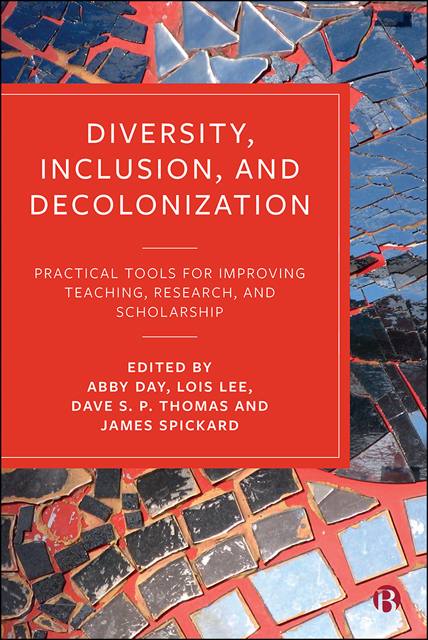 Diversity, Inclusion, and Decolonization
Diversity, Inclusion, and Decolonization Book contents
- Frontmatter
- Contents
- List of Figures and Tables
- Notes on Contributors
- Acknowledgements
- Typographical Note
- Introduction: Why Diversity, Inclusion, and Decolonization Matter
- Part I Changing Universities
- Part II Diversifying Curricula
- Part III Diversifying Research and Scholarship
- Part IV Overcoming Intellectual Colonialism
- Epilogue: What We Have Learned
- Index
9 - Towards an Intersectional Feminist Pedagogy of Gender-Based Violence
Published online by Cambridge University Press: 13 October 2022
- Frontmatter
- Contents
- List of Figures and Tables
- Notes on Contributors
- Acknowledgements
- Typographical Note
- Introduction: Why Diversity, Inclusion, and Decolonization Matter
- Part I Changing Universities
- Part II Diversifying Curricula
- Part III Diversifying Research and Scholarship
- Part IV Overcoming Intellectual Colonialism
- Epilogue: What We Have Learned
- Index
Summary
Denise: Students were pouring out the door of my first-year sociology class after a lecture on gender-based violence. A softspoken female student approached me, her male friend lingering behind her near the exit. Glancing back at him, she gingerly asked me: ‘We were wondering, what about male victims of domestic violence? You barely spoke of them, but aren’t they victims too?’
This was not the first time I had encountered this question. Many of the student essays I read on gender-based violence have, over the years, raised questions about the silence around male victims. Some more confident students had raised their hands in class to ask this question directly. What struck me in this instance, however, were two things.
First, neither of the students had felt comfortable raising the question in our two-hour class, and the male student seemed particularly reluctant to articulate the question himself. I wondered how many other students in that class left with similar questions gone unasked, and how those questions might have tugged uncomfortably at – or even undermined – their perception of the relevance of feminist theories of violence I presented. Had students left feeling resistant to a gendered account of violence because of this perceived silence? Were there male students with experiences of domestic or sexual violence who left with their experiences unaccounted for? What was the cost of not explicitly addressing these experiences, and, if I had, would I have pulled focus from the important question of gendered violence against women?
Second, it struck me that, of all the ‘what about’ questions I receive when teaching gendered violence, raising the experiences of male victims is the most common. Far less frequently, for example, am I asked about the unique experiences of non-binary or transgender people, people living with disabilities, or racial minorities. The pattern in ‘what about’ questions has always reflected the dynamics and make-up of my classroom: male students are present in numbers that command a symbolic quorum to make questions about male experience speakable – even if tentatively. Other minority students in the classroom do not.
- Type
- Chapter
- Information
- Diversity, Inclusion, and DecolonizationPractical Tools for Improving Teaching, Research, and Scholarship, pp. 140 - 154Publisher: Bristol University PressPrint publication year: 2022


